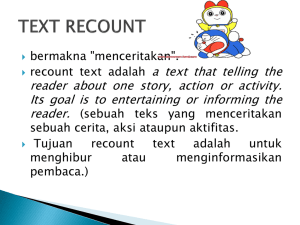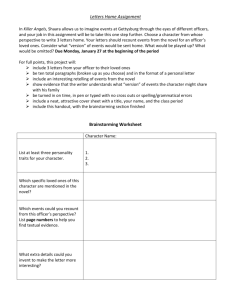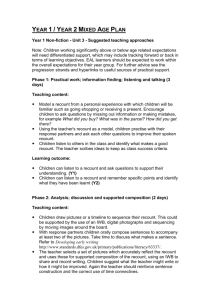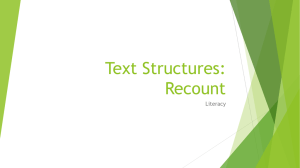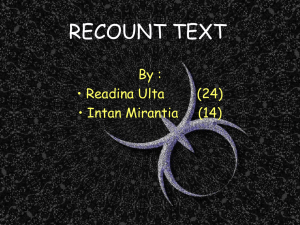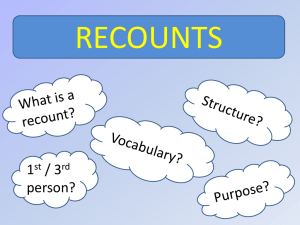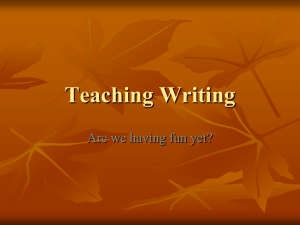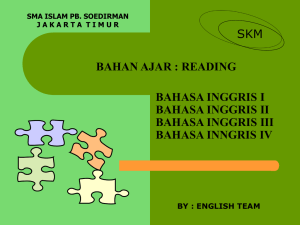Recounts Lesson Plan: Structure, Types, and Activities
advertisement
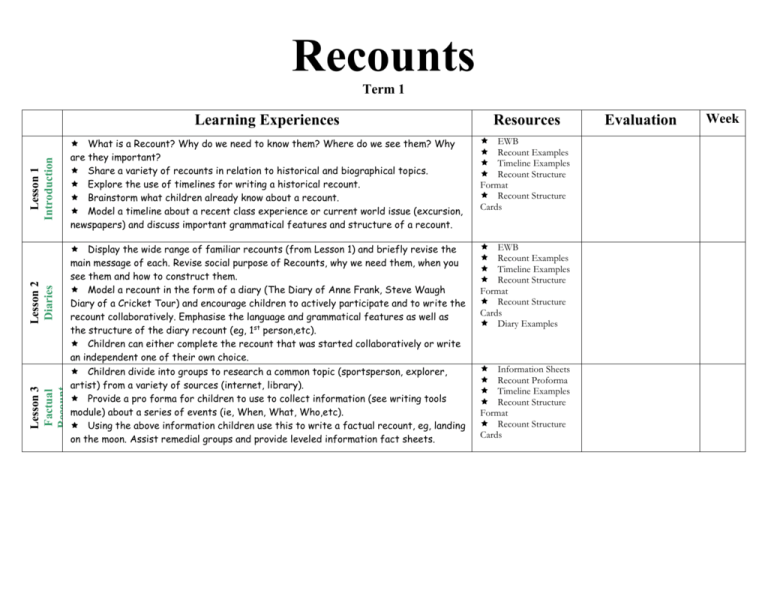
Recounts Lesson 3 Factual Recount Lesson 2 Diaries Lesson 1 Introduction Term 1 Learning Experiences Resources What is a Recount? Why do we need to know them? Where do we see them? Why are they important? Share a variety of recounts in relation to historical and biographical topics. Explore the use of timelines for writing a historical recount. Brainstorm what children already know about a recount. Model a timeline about a recent class experience or current world issue (excursion, newspapers) and discuss important grammatical features and structure of a recount. EWB Recount Examples Timeline Examples Recount Structure Format Recount Structure Cards Display the wide range of familiar recounts (from Lesson 1) and briefly revise the main message of each. Revise social purpose of Recounts, why we need them, when you see them and how to construct them. Model a recount in the form of a diary (The Diary of Anne Frank, Steve Waugh Diary of a Cricket Tour) and encourage children to actively participate and to write the recount collaboratively. Emphasise the language and grammatical features as well as the structure of the diary recount (eg, 1st person,etc). Children can either complete the recount that was started collaboratively or write an independent one of their own choice. Children divide into groups to research a common topic (sportsperson, explorer, artist) from a variety of sources (internet, library). Provide a pro forma for children to use to collect information (see writing tools module) about a series of events (ie, When, What, Who,etc). Using the above information children use this to write a factual recount, eg, landing on the moon. Assist remedial groups and provide leveled information fact sheets. EWB Recount Examples Timeline Examples Recount Structure Format Recount Structure Cards Diary Examples Information Sheets Recount Proforma Timeline Examples Recount Structure Format Recount Structure Cards Evaluation Week Lesson 4 Language & Grammar Lesson 5 Factual Recount Lesson 6 Recount Puzzle Examining Language and Grammatical features. Brainstorm and record on board. conjunction, eg when, then; connective, eg first, next; reported speech, eg Cathy Freeman said that she was excited about her win; noun group, eg the convict architect Francis Greenway. Read children a recount in first person and ask them to identify what changes would need to take place when changing the literary recount from first person to third person. Jointly construct this change and compare the two pieces of writing. Discuss the effects these changes make our understanding of the events. Homework: Newspaper Search. Children need to find an example of a recount from newspapers, magazines, etc. They then need to identify the purpose of the article and its effect on the audience (how did it make you feel? Develop a “Recount Bank” of all the different types of recounts that students encounter and encourage children to identify the purpose of each recount. Jointly construct a factual recount on a school event or school excursion for the school newsletter (make sure that children know that they are writing them for a purpose. Even create a one time “class newsletter” so that children have a reason for writing. In pairs/small groups, children plan their writing focusing on words/phrases to describe who, what, where, when, how, why? (See writing tools module). Explicitly define with children who their intended audience will be (students, family members of your school, etc). Outline important considerations. Have photographers take photos of the event and students are to take the role of journalists. Recounts are to be uploaded to the blog in the form of a newspaper article. Information Sheets Recount Proforma Timeline Examples Recount Structure Format Recount Structure Cards Computers Camera Blog Recount Puzzle. Children form small groups. Each group receives a set of five to ten events that they need to put into order. Recount Detectives. Children then need to identify the purpose of the recount, the intended audience, highlight descriptive language, characters and time connectives. Provide a time restriction for this to be completed with a reward for the most effective group (table points, etc). Whole Group Sharing. Children come back and form a large circle on the floor (sitting with group). Each group reads out their reconstructed recount and their theory for the purpose, audience, etc. Information Sheets Recount Proforma Timeline Examples Recount Structure Format Recount Structure Cards Deconstructed text EWB Recount Examples Timeline Examples Recount Structure Format Recount Structure Cards Recount 1st person example Lesson 7 Recount Visuals Lesson 8 Assessment Visual Recount Texts. Explore and examine the effect of visual texts in recounts. What is the purpose of these? Children re – examine one of their own recounts already written. Encourage children to identify the key events in their own recount and create a visual text to enhance these. Students create a visual Recount using Pixton comic maker. Recounts are to be uploaded to the class blog. Link into visual timelines, narrative illustration (Literary Recounts) and Factual Recounts. Assessment Information Sheets Recount Proforma Timeline Examples Recount Structure Format Recount Structure Cards
